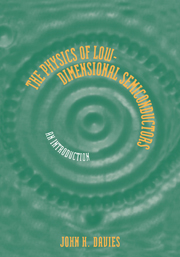Book contents
- Frontmatter
- Contents
- Preface
- Introduction
- 1 FOUNDATIONS
- 2 ELECTRONS AND PHONONS IN CRYSTALS
- 3 HETEROSTRUCTURES
- 4 QUANTUM WELLS AND LOW-DIMENSIONAL SYSTEMS
- 5 TUNNELLING TRANSPORT
- 6 ELECTRIC AND MAGNETIC FIELDS
- 7 APPROXIMATE METHODS
- 8 SCATTERING RATES: THE GOLDEN RULE
- 9 THE TWO-DIMENSIONAL ELECTRON GAS
- 10 OPTICAL PROPERTIES OF QUANTUM WELLS
- A1 TABLE OF PHYSICAL CONSTANTS
- A2 PROPERTIES OF IMPORTANT SEMICONDUCTORS
- A3 PROPERTIES OF GaAs–AlAs ALLOYS AT ROOM TEMPERATURE
- A4 HERMITE'S EQUATION: HARMONIC OSCILLATOR
- A5 AIRY FUNCTIONS: TRIANGULAR WELL
- A6 KRAMERS–KRONIG RELATIONS AND RESPONSE FUNCTIONS
- Bibliography
- Index
9 - THE TWO-DIMENSIONAL ELECTRON GAS
Published online by Cambridge University Press: 05 June 2012
- Frontmatter
- Contents
- Preface
- Introduction
- 1 FOUNDATIONS
- 2 ELECTRONS AND PHONONS IN CRYSTALS
- 3 HETEROSTRUCTURES
- 4 QUANTUM WELLS AND LOW-DIMENSIONAL SYSTEMS
- 5 TUNNELLING TRANSPORT
- 6 ELECTRIC AND MAGNETIC FIELDS
- 7 APPROXIMATE METHODS
- 8 SCATTERING RATES: THE GOLDEN RULE
- 9 THE TWO-DIMENSIONAL ELECTRON GAS
- 10 OPTICAL PROPERTIES OF QUANTUM WELLS
- A1 TABLE OF PHYSICAL CONSTANTS
- A2 PROPERTIES OF IMPORTANT SEMICONDUCTORS
- A3 PROPERTIES OF GaAs–AlAs ALLOYS AT ROOM TEMPERATURE
- A4 HERMITE'S EQUATION: HARMONIC OSCILLATOR
- A5 AIRY FUNCTIONS: TRIANGULAR WELL
- A6 KRAMERS–KRONIG RELATIONS AND RESPONSE FUNCTIONS
- Bibliography
- Index
Summary
The two-dimensional electron gas (2DEG) trapped at a doped heterojunction is the most important low-dimensional system for electronic transport. It forms the core of a field-effect transistor, which goes by many acronyms including modulation-doped field-effect transistor (MODFET) and high electron mobility transistor (HEMT). I shall use the first, which emphasizes the close relation to the silicon MOSFET but with MODulation doping. The silicon MOSFET is perhaps the most common electronic device, with electrons or holes trapped in an inversion layer at an interface between Si and SiO2. Many of the ideas in this chapter were originally derived for the MOSFET but it has been almost completely superseded in physics experiments by the MODFET because of the enormous improvement in the mobility of electrons and holes. The highest mobility of electrons in a MOSFET is around 4 m2 V−1 s−1, whereas values over 1000 m2 V−1 s−1 have been achieved in a MODFET. These mobilities are measured at low temperature, where they are limited by scattering from impurities, defects, and interfaces rather than phonons. The almost perfect crystalline quality of III–V heterostructures and the ability to separate carriers from the impurities that provide them by modulation doping mainly account for this huge difference.
First we shall study the electrostatics of modulation-doped layers to get estimates of important quantities such as the density of electrons, and then we shall develop models for the energy level and wave function of a two-dimensional electron gas.
- Type
- Chapter
- Information
- The Physics of Low-dimensional SemiconductorsAn Introduction, pp. 329 - 370Publisher: Cambridge University PressPrint publication year: 1997
- 1
- Cited by



